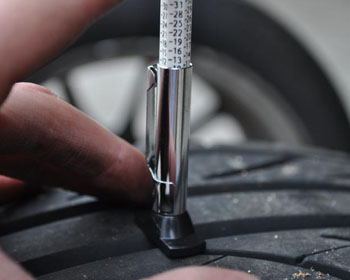Tyre Life and Why Quality Counts

Tyres may seem simple, but they’re one of the most important components of your car. Millions of dollars are spent in the development of new technology and materials each year.
When looked after, modern tyres offer longer life, improved safety and more impressive performance than we’ve ever come to expect from the rubber tyres of the past.
Here, we’ll take a look at how tyres wear, how to look after them to keep your family safe and what expensive tyres have over cheaper ones.
Tyre Age
You can check the age of your tyres by looking at the Tyre Identification Number (TIN) found on the tyre sidewall. The last four digits indicate the week and year the tyre was manufactured. For example a tyre with TIN ‘XXX4804’ was manufactured in the 48th week of 2004.
Unfortunately though, there’s no hard and fast rule to determine how long they’ll last. Regardless of age, tyres should be replaced if they show significant cracking in the tread grooves or sidewall and or bulging of the tread face or sidewall. It’s a warning sign to tell you they’re at the end of their life. How your tyres wear depends on a combination of many factors.
Factors that wear your tyres
Some tyres will wear faster because of their design characteristics, manufacturing materials and specific driver style. A tyre designed for high performance may wear faster than a tyre designed for comfort. Driving habits are a major factor in tyre life. Consistent hard braking and rapid acceleration will quickly wear a tyre. Impact with kerbs can also damage the tyre sidewall.
Rough road surfaces, unsealed roads, potholes and road objects can all contribute to tyre damage. Lack of tyre maintenance and suspension components can also see tyres wear prematurely. Regular air pressure checks, tyre rotation and balancing will not only increase the life of your tyres, but also reduce the chance of irregular wear developing.
If there’s any question about the roadworthiness of your tyres, please consult an expert at your local Bridgestone Tyre Store.
Testing was in accordance with ADR 81/02 on two identical 2017 Toyota Corolla Ascent Hatches fitted with tyre size 205/55R16.
Actual fuel consumption and CO2 emissions depend on factors such as traffic conditions, vehicle condition and driving style.
Ecopia tyre comparison performed against conventional tyres.
Tyre maintenance for safe driving
If you want your car to run smoothly, it’s important to take care of your tyres. Regular maintenance could save you trouble further down the line. Driving on neglected tyres could lead to problems with your braking, handling and fuel efficiency. Here’s how you check the condition of your tyres.
Check tyre appearance
Inspect each of the tyres and make sure there aren’t any cuts, tears or bulges on any of them. That there’s no significant cracking of the rubber in the tread grooves.
Check tyre pressure
Your tyre pressure is essential to keeping you safe. It’s not a bad idea to check every 4 weeks. Look inside the driver’s door or inside the petrol cap for the vehicle manufacturer’s recommended tyre pressure.
Under or over inflated tyres tend to wear irregularly, meaning you have less grip on the road. And remember to check your tyre pressure when the tyres are cool; tyres get quite warm when moving, which will increase the inflation pressure. By measuring the tyre pressure when it’s cool, you can be sure they’re inflated correctly.
Check tyre tread depth
The legal minimum tread depth for cars is 1.5mm in the main grooves, and around the entire circumference. Before your tread gets as low as this, you need to replace the tyre.
You can check by looking at the tread wear indicator bars moulded into the tyre tread. These are found at the bottom of the tread grooves around the tyre. When the tyre is worn to the point where any of the bars become equal with the adjacent tread, it’s time to replace it.
Tyre rotation for even wear
Different vehicles wear tyres at different rates. For example, a front-wheel drive car will wear the front tyres very differently to a rear-wheel drive. One of the best ways you can look after your tyres is by rotating them regularly, about every 5000km even if there is no sign of uneven wear.
Premium over cheap
Choosing the next set of tyres for your car can be confusing. And with a variation in price between premium and budget tyres, often the decision can be a bit overwhelming. Budget tyres tend to have similar looking tread patterns to the premium options, but that’s basically where any comparison ends.
Bridgestone invest millions in developing good quality and exceptionally safe tyres. They’re formulated with quality rubber compounds and developed with durable, long lasting materials. Tread patterns are rigorously tested in research centres, which replicate all driving conditions and extensively in real world applications.
What all this means is a tyre that offers greater performance in wet weather, produces shorter braking distances and improved comfort ride when compared to cheaper tyres, for an all-round safer tyre. Even though good quality tyres may cost more initially, they can return better fuel economy over the tyres’ life, last longer and more importantly provide safer motoring for you and your family.
See why safety is at the heart of everything we do here.
Share your thoughts if you think quality tyres are worth their weight in rubber. Let us know in the comments below.

Bridgestone Insider brings you all the latest updates, expert advice and guides from the team at Bridgestone New Zealand

